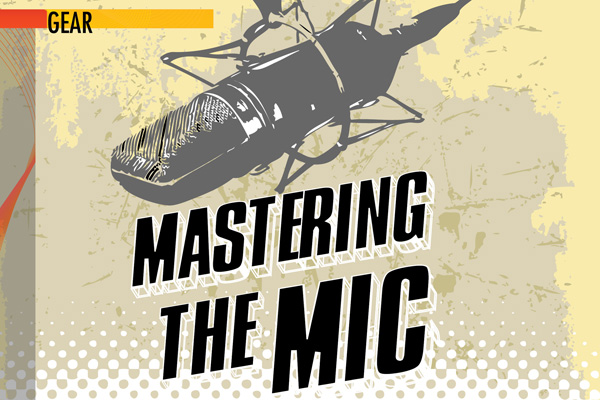 Selecting the right microphone for you is crucial to a sound performance
Selecting the right microphone for you is crucial to a sound performance
When you’re belting out a power ballad in front of thousands of excited fans or laying down a delicate guitar overdub in the studio, having the right microphone can make your music sound its best—and the wrong mic can turn it flat and lifeless. But with so many variations available, how do you choose? And with top-end mics selling for tens of thousands and cheapies going for under $100, how do you make the right choice for your budget?
We turned to Printz Board and Matt Boudreau to reveal the mysteries behind selecting the right microphone. Board is the musical director for the Black Eyed Peas, and has produced tracks for Natasha Bedingfield, the Backstreet Boys and Macy Gray. Boudreau, owner and chief engineer of Broken Radio Studios in San Francisco, has worked with acts including the Samples, Marcus Shelby Jazz Orchestra and jazz guitarist Mike Stern.
Do you have a favorite mic?
BOARD: The Neumann U87. When all else fails, it fits the majority of instruments and voices and produces a nice, clean tone that clearly represents the source of the sound. I use stock U87s for a clean, proper, crisp, real tone—not ones that have been modified to add extra color. It depends on the style of music you’re producing, but for me, there’s so much you can do to add color and grit after you’ve recorded.
BOUDREAU: Choosing a favorite mic for me is like choosing between siblings. There’s a small batch that I enjoy working with, but I can’t pick a favorite. The Shure SM7B is great for vocals, kick drum, bass guitar and even snare. We also have a Neumann U67 that was modified by [noted mic designer] Klaus Heyne—and this one is gorgeous on vocals and saxophone. The Audio-Technica AT4050 is like the Honda of microphones. It’s not incredibly expensive, but it’s utilitarian and bulletproof. It can take a high level of sound pressure and still sound great. For drum overheads, I’ve grown very fond of the Lauten Audio Horizons.
What’s a good mic for tracking vocals?
BOARD: Each person’s voice is different. Natasha Bedingfield, for example, has more gravel in her singing, so I didn’t want to accent that gravel too much—but I didn’t want it to totally disappear either. I used the Neumann U87. Sometimes I use the Telefunken Ela M 251, but I generally like Neumanns. M-Audio makes good mics too, and when I’m traveling, I always take them. With the Black Eyed Peas, we switch it up depending on the song. In general, the U87 gets the job done, but we might throw in a U47 if we want a grittier sound. I would never use that for [Black Eyed Peas singer] Fergie, though I might switch it up with the Telefunken for her.
How important is the mic when recording on a budget?
BOUDREAU: Even if you have a cheap workstation and cheap audio interface, anything you can do to improve the signal chain’s quality is important. When people ask me to mix tracks that they’ve recorded at home, if they’ve done them with a decent vocal mic, that’s half the battle.
BOARD: A good mic and a good preamp make a huge difference. Some high-quality mics I’ve worked with in the past have been great, but didn’t quite give me all the presence I needed. Then I got an Avalon VT-737sp preamp, which has a compressor and EQ built in—and suddenly everything sounded like a hit on the radio. Even if you can’t afford something like the 737, there are a lot of less expensive preamps you can use to help bring your mic to life.
What’s the difference between dynamic and condenser mics?
BOUDREAU: A dynamic is essentially the reverse of a speaker. There’s a coil of wire wrapped around a magnet, and that coil is attached to a diaphragm. When sound vibrations move the air, the air moves the diaphragm, which causes the coil to move around the magnet. That movement turns acoustical energy into electrical energy, which gets recorded. Dynamic mics can be great in high sound pressure situations, like miking a snare or kick drum. A condenser mic also has a diaphragm, but it acts as one plate of a capacitor, which is kept charged by phantom power. In simple terms, vibrations produce changes in the distance between the plates and that produces the electrical sound signal that gets recorded. Condensers tend to be far more sensitive to changes in sound than a dynamic or ribbon, so they’re great for things like vocals and strings.
What’s a ribbon mic?
BOUDREAU: Basically, there’s a ribbon made from metal that’s the thickness of a human hair. It’s suspended between two magnets and it works like a dynamic microphone, changing acoustical energy into electrical energy. The detail that a condenser captures is not going to come through with a ribbon. It gives more of an easy-listening sound by smoothing out aggressive high frequencies. Older ribbons were more sensitive to sound pressure and would easily be destroyed by something like a guitar amp, but with more modern technology, I’d be comfortable putting a Royer R-121 in front of a screaming Marshall stack.
BOARD: I love Royer ribbon mics. I use them a lot for recording brass, trumpet and trombone. Then maybe I’ll use an AKG 414 for sax and it comes out really nice. The Royers smooth out your sound for a jazzier, mellower vibe.
What’s the best way to learn about mics?
BOUDREAU: In Malcolm Gladwell’s book Outliers, he talks about spending 10,000 hours to become a true master of something. My advice to young engineers and producers is to know that you’re not going to gain all of your knowledge just from recording school and an internship. It’s going to come from thousands and thousands of hours of making mistakes, hating the results, and learning what certain mics do and don’t do.
BOARD: A lot is trial and error. Every part of a room has a different sound, and mic placement can be so important in and of itself. I recommend putting one mic in different locations, or singing the same phrase while standing at different distances from the mic, to see how the physics of the room and your proximity can affect the sound. When it comes to microphones, it’s all about the sound that you can get out of them. They don’t have to be expensive to sound good. I’ve had one-of-a-kind mics in velvet bags, and they just don’t sound like I want them to sound. You need to try different mics and see what delivers the sound you need.
BOUDREAU: It’s better to have fewer mics and know exactly how they work, how they’re built, their strengths and weaknesses, than it is to have a cabinet full of expensive mics that you’ve never experimented with and don’t know how to use. Sometimes you don’t have the luxury of being able to ponder and grab the perfect mic for a given situation—you just have to act quickly and capture a performance. At times like those, there are no rules and anything goes.
–Michael Gallant



comment closed